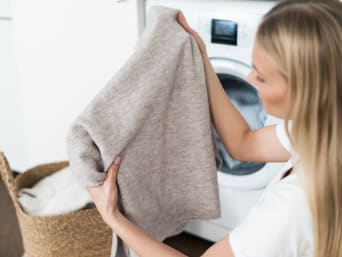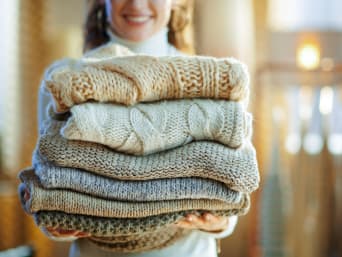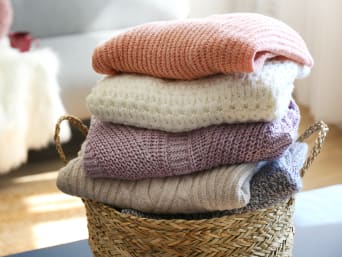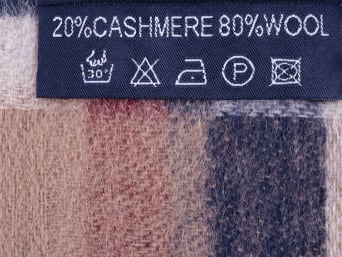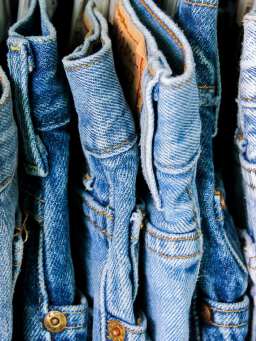How to wash wool
Cosy woolly jumpers and other clothes made out of wool are the perfect companions for winter. You need to look after your clothes made out of wool to ensure that you can get the most out of them. In the following guide we have put together the most important tips on how to wash and dry wool. You will also find some essential tips and tricks for common problems such as bobbling and shrinkage.
Washing wool
Wool is a natural fibre that comes from animals such as sheep, goats and alpacas. Similar to human hair, wool fibres therefore have a fine scale structure that can become rough if cared for incorrectly. This can then cause wool to bobble or shrink if it is exposed to high temperatures or other rough materials whilst being washed or dried. Therefore, it is recommended to wash wool at a low temperature to ensure that there is no shrinkage or damage to the fibres.

The care label will show you how you should wash a particular item of clothing. In most cases, handwashing is recommended, but lots of woollen clothes can also be washed on a gentle cycle in the washing machine. However, certain clothes made out of wool such as winter coats or suits should be dry cleaned.
Tips on how to wash wool
The best decision is to always handwash anything made out of wool if you don't want to take any risks or your washing machine doesn't have a suitable wash program. When handwashing wool keep the following tips below in mind:
Fill a sink or bowl with lukewarm water.
Use a mild laundry detergent such as a special wool or delicates laundry detergent and follow the recommended dosage.
Put the item of clothing in the water and then gently squeeze it to clean it. Avoid rubbing or wringing woollen clothes vigorously.
Leave your woollen clothes to soak in the water for a few minutes and then rinse them until the water becomes clear and no soap residue is visible.
Washing wool
Most clothes made out of wool or wool blends can be washed in the washing machine. However, you should still be careful so that you do not damage any of the delicate fibres in the material:
Make sure to wash wool only on a delicates wash program. Some washing machines have a special wash program specifically for wool, whereas other washing machines have a handwash or delicates wash program.
Make sure that the gentle wash program washes at the lowest possible temperature.
Most clothes made out of wool can only be spun at a very slow speed or in the best case they should not be spun at all.
Tip: Double check the care label before putting any woollen clothes in the washing machine. Do not wash woollen clothes at home in a washing machine, if dry cleaning or handwashing are advised.
How to wash wool: temperature
Wool should always be washed at a low temperature. A cold wash at 20°C or a maximum of 30 °Cis advised, as higher temperatures can cause the wool fibres to lose their shape or become twisted.
How to wash wool: the best laundry detergents for wool
When it comes to washing wool not only is choosing the correct wash program important, but also using the correct laundry detergent. It is recommended to use a mild laundry detergent that is suitable for wool. Laundry detergents for wool or delicates are pH-neutral and they do not contain any bleach or other harsh chemicals. This is why they are perfect for washing wool so that you can protect the delicate structure of the fibres.
If you don't have a suitable laundry detergent for wool, you can also use baby shampoo or a mild hair shampoo that is recommended for dry or a sensitive scalp.
Drying wool: how to prevent shrinkage
After washing wool it is important to make sure that you dry it properly. High temperatures in a tumble dryer can damage the delicate fibres. Even a delicates program on a tumble dryer can damage the fibres, therefore, follow our useful tips below on how to dry wool:
After washing wool it is usually very wet as it is recommended to not put wool on a spin cycle. It is best to carefully squeeze out the excess moisture, but do not wring it out.
Lay your washed woollen clothes on clean towels and gently roll them up to soak up most of the moisture.
You can leave the clothes to dry either by spreading them out on towels or laying them flat on a clothes horse. Make sure that the room is well aired.
It is important to always leave woollen clothes to dry lying down. Clothes made out of wool are a lot heavier when they are wet, therefore, if you hang them up they can become misshapen.
What to do in case of shrinkage
Wool can shrink when it is washed at a high temperature. Unfortunately, in some cases there isn’t anything you can do once it has shrunk. However, if your woollen clothes have lost a bit of their shape there are a couple of home remedies that you can try:
Fill your sink or a large bowl with lukewarm water. Now add some baby shampoo or a mild conditioner. We recommend using about one teaspoon per litre of water.
Leave your woollen jumper to soak for about half an hour and occasionally gently squeeze it so that the shampoo or conditioner can soak into the fibres. This will help to relax the fibres and make them more elastic again.
After leaving it to soak take your woollen jumper out of the water and gently squeeze out any excess water with a towel.
Lay the jumper on a clean towel. Next gently stretch the jumper slightly to bring it back into the desired shape. Gently pull the sleeves, the hem and the other parts to gradually stretch the item of clothing. Do not apply too much pressure as this can cause the fibres to tear.
Finally, leave your woollen jumper to dry lying down.
In most cases you will be able to get your jumper back into its original shape. However, it is important to remember that this method does not always give perfect results and is not suitable for woollen clothes that have severely shrunk.
How to stop clothes bobbling
New clothes made out of wool can bobble and these loose wool fibres can form small knots when they rub against each other. Therefore, it is a good idea to brush your new woollen clothes with a lint roller before wearing them for the first time as this will help to remove some of the loose fibres and prevent further bobbling. You can also carefully remove knots that have already formed with a lint shaver or a pilling comb.

Can you fix a bobbled woollen jumper? If an item of clothing made out of wool has been exposed to too much friction it can cause bobbling. This process is usually difficult or impossible to reverse, which is why you should always handle wool with care. However, give the following tip a go to see if it can make your woollen jumper supple again. A vinegar bath can help to make the fibres in wool more supple. Mix vinegar and water in a ratio of 1:4 and leave the wool to soak for about half an hour. Afterwards carefully squeeze the item of clothing and whilst it is still damp put it in a plastic bag and then pop it into the freezer and leave it there for about 24 hours.
FAQs on washing and drying wool
Clothes made out of wool are long lasting if you wash and dry them correctly. Below you will find answers to the most important questions on how to wash and dry wool:
How often should you wash wool?
Compared to most other materials, wool is quite resistant to dirt and odours. The keratin in the fibres in wool can absorb bacteria that causes bad odours and then break them down, so that your clothes stay smelling fresher for longer. Therefore, it is generally recommended to wash wool only when it is really dirty. However, in most cases you can leave woollen clothes out overnight to air.
Also consider how often you wear certain items of clothing and how much direct skin contact they have. Woollen shirts that you wear for sports will obviously need to be washed more often than a woollen coat that you wear over your clothes.
Is it okay to wash wool with fabric softener?
You shouldn’t wash wool with fabric softener. Fabric softener can block the delicate fibres in wool, which can cause woollen clothes to lose their elasticity and resilience. The residue left on the fibres can also make wool less breathable and less able to absorb moisture.
Can you iron wool?
It is rarely necessary to iron wool, as it usually dries quite well and it generally doesn’t crease. However, if you would like to iron certain items of clothing made out of wool make sure you iron them very gently. When ironing wool make sure that the iron is on a low setting, turn your clothes inside out, and do not apply too much pressure as this can damage the fibres.

The larvae from moths feed on keratin in woollen clothes. This causes holes on woollen clothing. To protect your clothes from moths, you can use lavender scented sachets or cedar wood rings. Their intense scent will deter moths. You can also wrap your favourite clothes in tissue paper for extra protection.
The different types of wool
Below we have listed the different types of wool and their special properties:
Virgin wool
Virgin wool refers to classic sheep's wool. It is robust and hard-wearing, making it particularly suitable for jumpers, coats and suits. Like all types of wool, it is very breathable, can absorb moisture well and will keep you warm.
Lamb’s wool
Lamb's wool comes from lambs that are usually less than a year old and have never been shorn before. Lamb's wool is particularly soft, finer and more elastic than virgin wool.
Merino wool
The wool from merino sheep is considered particularly soft and warm. Merino wool has excellent thermal insulation, it is breathable and can wick away moisture to ensure a dry and comfortable feeling. Therefore, it is particularly suitable for sportswear, underwear or socks.
Cashmere
The wool from a cashmere goat is one of the finest and most luxurious types of wool. Cashmere has a silky sheen and is luxuriously soft. The fibres in cashmere are more robust, softer and more insulating than virgin wool and at the same time they are very light, which makes cashmere very comfortable to wear.
Angora wool
This high-quality fluffy type of wool comes from angora rabbits. Angora wool is excellent at storing heat thanks to its airy fibre structure. Angora wool requires gentle care, otherwise it bobbles very easily. New items of clothing made out of angora wool can quite often bobble.
Alpaca wool
This type of wool comes from alpacas, which are a South American camel species that can only be shorn once or twice a year. Alpaca wool is lighter than virgin wool and at the same time offers excellent thermal insulation.
Mohair
Mohair comes from angora goats and is known for its smooth, silky texture. Mohair wool is light, insulating and can absorb moisture well.
Conclusion: how to wash and dry wool
Wool is a durable material and with the right care you can get the most out of your favourite woollen clothes. Make sure to avoid washing wool at high temperatures. Instead, it is best to wash your woollen clothes by hand or on a delicates wash program with a mild laundry detergent or with a laundry detergent specifically for wool. Remember to not spin dry wool as this will help to protect the special fibres from getting damaged that will help to keep you warm and dry.
______________________________________________
The image sources in this text are in chronological order
Cover photo: iStock.com/brizmaker
1. Image in text: iStock.com/CentralITAlliance
2. Image in text: iStock.com/Aliaksandr Litviniuk
3. Image in text: iStock.com/Evrymmnt
4. Image in text: iStock.com/Olga_Anourina
5. Image in text: C&A
